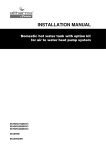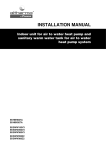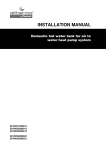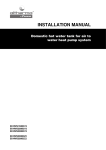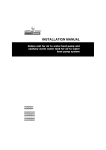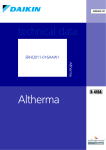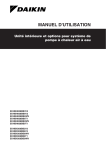Download INSTALLATION MANUAL
Transcript
INSTALLATION MANUAL Sanitary water tank with option kit for air to water heat pump system Do not use the installation manual supplied with the EKSWWU sanitary water tank, but EKSWWU150V3 EKSWWU200V3 EKSWWU300V3 EKUSWW use this manual instead. EKSWWU150V3 EKSWWU200V3 EKSWWU300V3 CONTENTS EKUSWW Sanitary water tank with option kit for air to water heat pump system Page Introduction ....................................................................................... 1 General information .................................................................... 1 Scope of this manual .................................................................. 1 Model identification ..................................................................... 1 Accessories....................................................................................... 2 Accessories supplied with the EKSWWU sanitary water tank.... 2 Accessories supplied with the EKUSWW option kit for the sanitary water tank .......................................................... 2 Installation of the EKSWWU sanitary water tank .............................. 2 Main components ....................................................................... 2 Outlook diagram ......................................................................... 3 Installation guidelines ................................................................. 3 Installing the sanitary water tank ................................................ 4 Connecting the water circuits...................................................... 4 Field wiring ................................................................................. 4 Installation of the option kit on the Sanitary water tank..................... 7 Piping requirements.................................................................... 7 Installation procedure of the option kit ........................................ 8 Commisioning ................................................................................... 8 Filling up ..................................................................................... 8 Draining ...................................................................................... 9 Maintenance ..................................................................................... 9 Troubleshooting................................................................................. 9 Technical specifications .................................................................. 10 General ..................................................................................... 10 Sanitary water tank specifications ............................................ 10 Field wiring diagram.................................................................. 10 Installation manual INTRODUCTION General information Thank you for purchasing this sanitary water tank. EKSWWU The sanitary water tank must be installed by a competent person and be installed in compliance with instructions as of subject in this manual, all current legislation, codes of practice and regulations governing the installation of unvented hot water cylinders in force at the date of installation. This installation is subject to building regulation approval, notify Local Authority of intention to install. The sanitary water tank is to be connected to the EKHBH/X indoor unit, the indoor part of the reversible air to water Daikin ERYQ heat pumps. The EKSWWU sanitary water tank with integrated 3kW electrical booster heater is available in three types: 150, 200 and 300. All models can be floor mounted, while the 150 type model can be wall mounted as well via option kit EKWBSWW150. Scope of this manual This installation manual describes the procedures for installing and connecting the option kit for the EKSWWU sanitary water tanks. Please also refer to the indoor unit installation manual supplied with the EKHB/X unit for standard installation of the EKSWW sanitary water tank, i.e. in relation to following chapters especially: ■ Typical application examples READ THESE INSTRUCTIONS CAREFULLY BEFORE INSTALLATION. KEEP THIS MANUAL IN A HANDY PLACE FOR FUTURE REFERENCE. ■ Overview of the indoor unit ■ Installation of the indoor unit ■ Start-up and configuration PLEASE LEAVE THIS MANUAL WITH THE EKSWWU SANITARY WATER TANK AFTER INSTALLATION. IMPROPER INSTALLATION OR ATTACHMENT OF EQUIPMENT OR ACCESSORIES COULD RESULT IN ELECTRIC SHOCK, SHORT-CIRCUIT, LEAKS, FIRE OR OTHER DAMAGE TO THE EQUIPMENT. BE SURE ONLY TO USE ACCESSORIES MADE BY DAIKIN WHICH ARE SPECIFICALLY DESIGNED FOR USE WITH THE EQUIPMENT AND HAVE THEM INSTALLED BY A PROFESSIONAL. IF UNSURE OF INSTALLATION PROCEDURES OR USE, ALWAYS CONTACT YOUR DAIKIN DEALER FOR ADVICE AND INFORMATION. THE UNIT DESCRIBED IN THIS MANUAL IS DESIGNED FOR INDOOR INSTALLATION ONLY AND FOR AMBIENT TEMPERATURES RANGING 0˚C~35˚C. ■ Test run and final check ■ Maintenance ■ Troubleshooting NOTE Installation of the ERYQ heat pump outdoor is described in the outdoor unit installation manual. Operation of the indoor unit is described in the indoor unit operation manual. Model identification Sanitary water tank (optional) EK SWW U 150 V3 Booster heater voltage V3 = 1P, 230 V Indication of storage capacity Special version for United Kingdom only Standard version when no letter is mentioned Sanitary Warm Water European Kit Installation manual 1 EKUSWW + EKSWWU150-300V3 Sanitary water tank with option kit for air to water heat pump system 4PW37176-1 ACCESSORIES INSTALLATION OF THE EKSWWU SANITARY WATER TANK Accessories supplied with the EKSWWU sanitary water tank 1 2 1x 3 1x 4 2x ■ The total system (indoor unit and outdoor unit) is designed for combination with an sanitary water tank. In case another tank or a spare part other than native Daikin is being used in combination with the indoor unit, Daikin cannot guarantee neither good operation nor reliability of the system. For those reasons Daikin cannot give warranty of the system in such case. ■ For safety reasons, it is not allowed to add ethylene glycol to the water circuit. Adding ethylene glycol might lead to contamination of the sanitary water if a leakage would occur in the heat exchanger coil. 5 3x 1 Thermistor + connection wire (12 m) 2 Prewired contactor and circuit breaker assembly 3 Contactor fixing screw 4 PG nipple and nut 5 Installation manual 1x Main components Accessories supplied with the EKUSWW option kit for the sanitary water tank H 2 1 1 2 1x 3 1x 4 1x 1x 3 4 5 6 1x 7 1x 8 1x 5 6 1x 7 F 8 9 10 1x 1x 11 1x 12 1x 13 1x 1 Pressure reducing valve with integrated non return valve, line strainer and expansion relief valve 2 Blind stop + 2 plastic screw-on closing caps for pressure reducing valve 3 T-piece 1/2” Female BSP x 15 mm x 15 mm 4 Expansion vessel of 18 litres 5 Tundish 11 9 R 10 C 6 Elbow/Drain valve 22 mm x 3/4”Male BSP 7 Instruction sheet (Refer to the manual...) 8 Solenoid 2-way valve 3/4”Female BSP x 3/4”Female BSP 1 Hot water connection 9 T-piece 22 mm x 1/2”Female BSP x 22 mm 2 Temperature and pressure relief valve 10 T-piece 22 mm x 22 mm x 22 mm 3 Electrical box 11 Adaptor 1/2”Male BSP x 15 mm 4 Electrical box lid 12 Adaptor 22 mm x 3/4”Female BSP 5 Booster heater 13 Expansion relief valve 1/2”Male BSP x 1/2”Female BSP 6 Threaded thermistor hole 7 Flow inlet connection 8 Heat exchanger coil EKUSWW + EKSWWU150-300V3 Sanitary water tank with option kit for air to water heat pump system 4PW37176-1 9 Return outlet connection 10 Cold water connection 11 Warning label Installation manual 2 Safety devices ■ The sanitary tank relief valve connections should not be used for other purpose. ■ Do not install heaters without thermal cut-outs. ■ Thermal protector — The booster heater in the sanitary water tank is equipped with a thermal protector (setting 85°C). ■ Secondary thermal protector (solenoid 2-way valve) — The thermal protector will close the solenoid 2-way valve (setting 85°C). Outlook diagram 1/2" BSP 7 8 Both thermal protectors are activated when the temperature becomes too high. When activated, the protectors have to be reset on the sanitary water tank by pressing the red button (for access, remove the electrical box lid). 9 1/2" BSP The electrical box lid must only be opened by a licensed electrician. 2 3/4" BSP Switch off the power supply before opening the electrical box lid. ■ 6 1 3/4" BSP H2 H1 3 Thermostat (solenoid 2-way valve) The thermostat will close the solenoid 2-way valve when the temperature becomes too high (setting 75°C). ■ Temperature and pressure relief valve The temperature and pressure relief valve prevents excessive water temperature (>95°C) and excessive water pressure (≥10 bar) in the sanitary water tank. ■ 630 4 3/4" BSP Pressure relief valve (option kit) 5 The pressure relief valve prevents excessive water pressure (≥8 bar) in the water circuit. 3/4" BSP 220 110 NOTE Refer to "Installation of the option kit on the Sanitary water tank" on page 7 for connection of other safety devices in accordance with relevant local and national regulations. 0 0~40 Ø580 1 Hot water connection 2 Threaded thermistor hole 3 Flow inlet connection (see also "Installation guidelines" on page 3 regarding pipe size to use) 4 Return outlet connection (see also "Installation guidelines" on page 3 regarding pipe size to use) 5 Cold water connection 6 Temperature and pressure relief valve connection 7 Cable hole to fit PG nipple and nut into for cable connections of booster heater, power supply and thermal protection cable 8 Cable hole to fit PG nipple and nut into for cable connections of solenoid valve power supply 9 Cable hole to fit PG nipple and nut into for cable connections of solenoid valve Sanitary water tank model H1 H2 EKSWWU150V3 900 1015 EKSWWU200V3 1150 1265 EKSWWU300V3 1600 1715 Installation guidelines Keep in mind the following guidelines when installing the sanitary water tank: Installation manual 3 ■ The installation location is frost-free. ■ Make sure to make the piping in size 1" or more (and reduce to 3/4" at the inlet of the tank) as to have sufficient water volume in the piping between indoor unit and sanitary water tank. ■ Locate the sanitary water tank in a suitable position to facilitate easy maintenance; remember access is required to the electrical box. EKUSWW + EKSWWU150-300V3 Sanitary water tank with option kit for air to water heat pump system 4PW37176-1 ■ ■ The sanitary water tank model EKSWWU150V3 can be floor or wall mounted. In case of wall mounting, wall mounting kit EKWBSWW150 is required (separate ordering). If installing an EKSWWU* sanitary water tank, installing the option kit EKUSWW is obligatory. Refer to the UK Building Regulation G3. Procedure Switch off the connections. power supply before making any Connections to be made in the sanitary water tank electrical box 1 Prior to upwiring Make sure to ensure strain relief of all cables by correctly mounting the PG nipples and PG nuts (accessories supplied with the sanitary tank parts 4). Installing the sanitary water tank Check if all sanitary water tank accessories (see "Accessories" on page 2) are enclosed. 2 When floor mounting, place the sanitary water tank on a level surface. When wall mounting (only for EKSWWU150V3 model), make sure the wall is sturdy. In both cases, make sure the tank is mounted level. 3 Apply contact glue to the thermistor and insert the thermistor as deep as possible in the thermistor socket. Fix using the nut provided. 1 Connecting the water circuits To install adequate connections between the indoor unit and the sanitary water tank, it is important that the 3-way valve is fitted correctly. NOTE Refer to "Installation of the option kit on the Sanitary water tank" on page 7 for details on installation in accordance with relevant local and national regulations. Field wiring 2 3 1 Cable hole to fit PG nipple and nut into for cable connections of booster heater, power supply and thermal protection cable 2 Cable hole to fit PG nipple and nut into for cable connections of solenoid valve power supply 3 Cable hole to fit PG nipple and nut into for cable connections of solenoid valve Booster heater power supply Connect the booster heater power supply and thermal protection cable as shown in the wiring diagram A below. Wiring diagram A X6M BRN Q2L ■ Power circuit and cable requirements ■ ■ 1 3 2 4 2 4 1 1 3 2 2 Q3L Q1T 2 E4H Be sure to use a dedicated power circuit. Never use a power circuit shared by another appliance. Use one and same dedicated power supply for the outdoor unit, indoor unit, backup heater and sanitary water tank. For cable requirements and specifications, refer to "Field wiring" in the indoor unit installation manual supplied with the EKHB/X unit. NOTE 3 YLW/ GRN ■ All field wiring and components must be installed by a licensed electrician and must comply with relevant European and national regulations. The field wiring must be carried out in accordance with the wiring diagram sticker supplied with the unit and the instructions given below. The sanitary water tank must be earthed via the indoor unit. 1 BRN Also refer to "Field wiring diagram" on page 10. ■ X5M BLK YLW/GRN Refer to the chapter “Typical application examples” described in the installation manual delivered with the indoor unit for details on connecting the water circuits and the motorised 3-way valve. 2 BLK 1 8 7 21 22 BLK Black BLU BRN Brown YLW/GRN Blue Yellow/green Select the power cable in accordance with relevant local and national regulations. Thermistor cable The distance between the thermistor cable and power supply cable must always be at least 5 cm to prevent electromagnetic interference on the thermistor cable. EKUSWW + EKSWWU150-300V3 Sanitary water tank with option kit for air to water heat pump system 4PW37176-1 Installation manual 4 3 Solenoid valve power supply Connections to be made in the indoor unit switch box Connect the solenoid valve power supply cable as shown in the wiring diagram B below. Wiring diagram B 5 Mount the prewired contactor (K3M) and circuit breaker (F2B). The contactor should be fixed with the two screws supplied. 6 Connect the loose ends of the contactor to terminal 7 and 8 on the terminal block and the connector in the socket X13A on the PCB. 7 Plug the thermistor cable connector in the socket X9A on the PCB. 8 Connect the booster heater power supply and thermal protection cable (field supply) to terminal 7, 8, 21, 22 and earth on the terminal block. 9 Connect the solenoid valve power supply cable to terminal block X7M as shown on Wiring diagram B in paragraph "Connections to be made in the sanitary water tank electrical box" on page 4. 10 Connect the booster heater power supply cable to the circuit breaker (F2B) and earthing screw. 11 Fix the cables to the cable tie mountings with cable ties to ensure strain relief. 12 Set DIP switch SS2-2 on the PCB to ON. See "DIP switch settings overview" in the indoor unit installation manual supplied with the EKHBH/X unit for more information. X6M indoor unit switch box X5M YLW/GRN 1 3 2 4 BRN 1 3 2 4 X7M F2U Q3L 3 Q1T L N Note: only relevant field wiring is shown. Solenoid valve K3M Connect the solenoid valve as shown in the wiring diagram C below. Wiring diagram C X5M 8 10 12 14 16 18 20 22 23 K4M ON X6M SS2 OFF X13A solenoid valve coil Y1S 1 2 3 4 4 X9A 7 9 11 13 15 17 19 21 X7M BRN YLW/GRN F2U 1 3 1 3 X7M Q3L 2 4 2 4 1 3 Q1T F2B 2 >50 mm L N 230 V AC 3 kW X5M 8 7 Installation manual 5 21 22 EKUSWW + EKSWWU150-300V3 Sanitary water tank with option kit for air to water heat pump system 4PW37176-1 NOTES EKUSWW + EKSWWU150-300V3 Sanitary water tank with option kit for air to water heat pump system 4PW37176-1 Installation manual 6 INSTALLATION ■ ■ OF THE OPTION KIT ON THE SANITARY WATER TANK All pipework and fittings must be flushed free of all flux and debris prior to the fitting of controls of this option kit. Failure to do this may cause irrepairable damage to the controls. All cautions as under chapter "Installation of the EKSWWU sanitary water tank" on page 2 remain of extreme importance and are equally valid in this chapter. 8 ≤500 mm 2 6 H D1 ≤500 mm 11 10 D1 3 8 F >300 mm 10 14 13 D2 5 9 8 8 15 R C Fixed grating 7 Trapped effluent water Sizing of copper discharge pipe D2 for common temperature relief valve outlet sizes Piping requirements ■ Tundish Install the tundish in a vertical position within a maximum of 500 mm away from the temperature and pressure relief valve and pressure reducing valve. ■ Valve outlet size Tundish pipework Tundish pipework must be 22 mm metal pipe with a minimum vertical length of 300 mm below the tundish. Maximum permitted (equivalent) length of 22 mm pipework is 9 m. Each bend or elbow is equivalent to 0.8 m of pipework. All pipework must have a continuous fall. G1/2 ■ Maximum resistance allowed, expressed as a Discharge pipe length of straight Resistance Discharge pipe size D2 created by each pipe (i.e. no size D1 from tundish elbows or bends) elbow or bend 15 mm 22 mm up to 9 m 0.8 m Requirements to discharges ■ Discharge piping, tundish, drain valves, etc. must be positioned away from any electrical components. ■ The discharge pipe away from the tundish must terminate in a safe, visible position without forming any risk to persons in the vicinity. If in any doubt, refer to Building Regulation G3. Do not install any valves between the sanitary water tank and relief valves/expansion vessel. Installation manual 7 EKUSWW + EKSWWU150-300V3 Sanitary water tank with option kit for air to water heat pump system 4PW37176-1 Installation procedure of the option kit 1 Locate the sanitary water tank in a suitable position to facilitate the installation of water supply, discharge fittings and pipework. It is therefor recommended to first read through this whole procedure. 13 Flow inlet connection 14 Refer to the figure on the facing page at the start of this chapter for full understanding of next procedure steps. Pre-assembly 2 Pre-assemble the pressure reducing valve (part 1 of this kit) by mounting the blind stop and the 2 black plastic screw-on closing caps (part 2 of this kit), so that the pressure reducing valve is ready for installation. The black plastic plugs in the Pressure reducing valve body are pressure gauge connections to enable pressure monitoring to be carried out, should the system develop a fault. It is recommended that these be accessible (the pressure reducing valve has two - only one need be accessible). 3 Pre-assemble the T-piece and tundish (parts 3 and 5 of this kit) so that tundish is ready for installation. 4 — 5 Pre-assemble the adaptor and expansion vessel (part 12 and 4 of this kit) so that the expansion vessel is ready for installation. 6 Manually operate the temperature and pressure relief valve to ensure free water flow through discharge pipe. Turn knob left. Connect a discharge pipe from the tundish. Refer to paragraph "Tundish pipework" on page 7“. All pipework must have a continuous fall and be fitted conform to the requirements of the Building Regulation G3. Fit the solenoid 2-way valve (part 8 of this kit) on a minimum length of 3/4”-threaded pipe connector (not supplied with the kit) for screwing into the 3/4”FBSP flow inlet connection <F> of the sanitary water tank. Also refer to "Installation guidelines" on page 3. ■ The valve must be mounted so that the valve head is above horizontal level of pipework to prevent that in the highly unlikely event of a leak, a safety hazard results. ■ Check direction of the flow arrow cast on the solenoid valve body. ■ Do not grip the valve head while making and tightening up connections. Either hold brass body in your hand or attach adjustable spanner across hexagonal or flat faces in valve body at each port’s screw thread. 15 Make sure that the solenoid 2-way valve is wired up properly as described in "Connections to be made in the sanitary water tank electrical box" on page 4. 16 After completing the installation, the installer has to fill in the warning label on the tank with indelible ink. Refer to "Main components" on page 2 for location of the warning label. ■ ■ WARNING TO INSTALLER Water main in ■ 7 Fit the elbow/drain valve (part 6 of this kit) in the cold water connection <C> of the sanitary water tank. 8 Position the Pressure reducing valve with integrated non return valve, line strainer and expansion relief valve (part 1 of this kit see also procedure step 2) as high as possible and connect it to the water mains inlet. Do not remove Contact the installer. Should the system develop a fault, switc contact the installer. ■ ■ This installation is subject to building regulation approval, notify Local Authority of intention to install. Use only manufacturer's recommended spare parts. Contact your local Daikin dealer. Installed by name address tel. No. completion date ■ The pressure reducing valve must be installed higher than the temperature and pressure relief. ■ The pressure reducing valve must be installed with the discharge from the expansion valve horizontal - if fitted inverted, debris may be deposited on the seat and cause fouling of the seat when the valve operates. Check direction of flow arrows. 9 COMMISIONING Fit a length of copper tube Ø22 mm (field supply) inbetween the elbow/drain valve (procedure step 4) and the pressure reducing valve. Filling up Make sure to provide for a connection on this pipe to the expansion vessel (part 10 of this kit). 1 Switch off the power supply. 2 Open each hot water tap in turn to expel air from the system pipe work. 3 Open the cold water supply valve. 4 Check for leaks. 5 Close all water taps if all air is expelled. 6 Manually operate the temperature and pressure relief valve to ensure free water flow through the discharge pipe (turn knob left). Refer to "Main components" on page 2 for location of the temperature and pressure relief valve. Fit a length of copper tube Ø22 mm (field supply) inbetween the T-piece (part 10 of this kit) and the pre-assembled expansion vessel (procedure step 5 and 8). Discharge 10 Install the tundish in a vertical position within a maximum of 500 mm away from the temperature and pressure relief valve and pressure reducing valve. (Procedure step 3). Make sure that you install it so that you can still connect the 1/2” outlet of the expansion relief valve (on the pressure reducing valve) and the horizontal inlet of the T-piece on top of the tundish. (Procedure step 11) 11 Connect a metal discharge pipe Ø15 mm (field supply) from the temperature and pressure relief valve to the vertical inlet of the T-piece on top of the tundish (≤500 mm). 12 — EKUSWW + EKSWWU150-300V3 Sanitary water tank with option kit for air to water heat pump system 4PW37176-1 Follow the next steps to fill up the tank: Installation manual 8 Draining TROUBLESHOOTING Follow the next steps to drain the tank: This section provides useful information for diagnosing and correcting certain troubles which may occur in the unit. 1 Switch off the power supply. 2 Turn off the cold water supply valve. 3 Open the hot water taps. 4 Open the drain valve. MAINTENANCE In order to ensure optimal availability of the unit, a number of checks and inspections on the unit and the field wiring have to be carried out at regular intervals. ■ ■ Before carrying out any maintenance or repair activity, always switch off the circuit breaker on the supply panel, remove the fuses or open the protection devices of the unit. Make sure that before starting any maintenance or repair activity, also the power supply to the outdoor unit is switched off. The described checks must be executed at least once a year. 1 When carrying out an inspection on the supply panel or on the switch box of the unit, always make sure that the circuit breaker of the unit is switched off. When a safety device was activated, stop the unit and find out why the safety device was activated before resetting it. Under no circumstances safety devices may be bridged or changed to a value other than the factory setting. If the cause of the problem cannot be found, call your local Daikin dealer Symptom 1: No water flow from hot taps POSSIBLE CAUSES Pressure reducing valve with integrated non return valve, line strainer and expansion relief valve. Check for correct operation of the expansion relief valve. Manually operate the expansion relief valve to ensure free water flow through discharge pipe. Turn knob left. Depending on local water conditions, annual inspection of the integral line strainer, pressure reducing valve cartridge, expansion relief valve cartridge and seating may be necessary. ■ Pressure reducing valve - Unscrew the retaining nut of the valve. The complete operating mechanism, including the strainer can be removed. - Clean the filter mesh and cartridge under running water. - Replace cartridge, ensuring that strainer is correctly located and reassemble the unit. Depending on local water conditions, annual inspection of the expansion relief valve cartridge and seating may be necessary. - Unscrew the expansion relief headwork from valve body. - Clean valve seat face and seating - do not scratch or damage either seat face or seating. - Refit in reverse order. Do not over tighten. 4 Indoor unit switch box ■ Carry out a thorough visual inspection of the switch box and look for obvious defects such as loose connections or defective wiring. ■ Check for correct operation of contactor K3M by use of an ohmmeter. All contacts of this contactor must be in open position. Installation manual 9 ACTION Check that all shut off valves of the water circuit are completely open. The strainer is blocked. Turn off the water supply, remove and clean the strainer (see "Pressure reducing valve with integrated non return valve, line strainer and expansion relief valve." on page 9 on how to do this). The cold water inlet pressure reducing valve is not fitted properly. Check and refit as required (see "Pressure reducing valve with integrated non return valve, line strainer and expansion relief valve." on page 9 on how to do this). Symptom 2: Water from hot taps is cold POSSIBLE CAUSES CORRECTIVE ACTION The thermal cut-out(s) has/have operated Check and reset button(s). The indoor unit (EKHBH/X) is not operating. Check the indoor unit (EKHBH/X) operation. Refer to the manual delivered with the indoor unit. If any faults are suspected, contact your local Daikin dealer. The solenoid 2-way valve is not operating correctly. Check the wiring, F2U and the plumbing connections to the solenoid 2-way valve. Check the setting of the thermostat (75°C). Symptom 3: Intermittent water discharge POSSIBLE CAUSES CORRECTIVE ACTION Thermal control failure (water will be hot). Switch off power to the indoor unit. When discharge has stopped, check the thermal controls and replace if faulty. Contact your local Daikin dealer. The expansion vessel is broken. Replace the expansion vessel. ■ Expansion relief valve Check for correct operation of the expansion relief valve. Manually operate the expansion relief valve to ensure free water flow through discharge pipe. Turn knob left. CORRECTIVE The main water supply is off. Temperature and pressure relief valve Check for correct operation of the temperature and pressure relief valve. Manually operate the temperature and pressure relief valve to ensure free water flow through discharge pipe. Turn knob left. 3 Before contacting your local dealer, read this chapter carefully, it will save you time and money. Sanitary water tank booster heater It is advisable to remove lime buildup on the booster heater to extend its life span, especially in regions with hard water. To do so, drain the sanitary water tank, remove the booster heater from the sanitary water tank and immerse in a bucket (or similar) with lime-removing product for 24 hours. 2 Before starting the trouble shooting procedure, carry out a thorough visual inspection of the unit and look for obvious defects such as loose connections or defective wiring. Symptom 4: Continuous water discharge POSSIBLE CAUSES CORRECTIVE ACTION Cold water inlet pressure. Check the pressure reducing valve. Replace the pressure reducing valve if the measured pressure is >2.1 bar. Temperature and pressure relief valve. Check and reset button. The expansion relief valve is not functioning properly. Check for correct operation of the pressure relief valve by turning the red knob on the valve counter clockwise: • If you do not hear a clacking sound, contact your local Daikin dealer. • In case the water keeps running out of the unit, close both the water inlet and outlet shut-off valves first and then contact your local Daikin dealer. EKUSWW + EKSWWU150-300V3 Sanitary water tank with option kit for air to water heat pump system 4PW37176-1 TECHNICAL SPECIFICATIONS General Heating/cooling models (EKHBX) Heating only models (EKHBH) –15~+35°C(a) –15~+35°C(a) Operation range - air side • sanitary water by heat pump (a) Down to –20°C by booster heater and up to +43°C by booster heater Sanitary water tank specifications • Storage capacity • Overall dimensions (Ø x H) • Booster heater - power supply - running current - capacity • Operating pressure • Maximum primary working pressure (heating side) • Expansion vessel pre-charge pressure • Preset opening pressure of expansion relief valve • Preset opening temperature of temperature and pressure relief valve • Set opening pressure of temperature and pressure relief valve • Connections • Weight - empty - when full • Mounting • Supply temperature time(b) • Maximum water supply pressure • Re-heat time(c) EKSWWU150V3 EKSWWU200V3 EKSWWU300V3 150 l 580 x 1015 mm 230 V 50 Hz 1P 13 A 3 kW 2.1 bar 200 l 580 x 1265 mm 230 V 50 Hz 1P 13 A 3 kW 2.1 bar 285 l 580 x 1715 mm 230 V 50 Hz 1P 13 A 3 kW 2.1 bar 2.5 bar 2.5 bar 2.5 bar 2.5 bar 2.5 bar 2.5 bar 8 bar 8 bar 8 bar 90~95°C 90~95°C 90~95°C 10 bar 10 bar 10 bar 3/4” FBSP(a) 38 kg 188 kg Wall or floor 1 hr 15 min 8 bar 1 hr 5 min 3/4” FBSP(a) 46 kg 246 kg Floor 1 hr 41 min 8 bar 1 hr 29 min 3/4” FBSP(a) 60 kg 345 kg Floor 2 hr 26 min 8 bar 2 hr 8 min (a) FBSP = Female British Standard Pipe (b) The time it takes to increase the temperature from 15°C to 60°C (c) The time it takes to increase 70% of the contents of the vessel back up to 60°C Field wiring diagram solenoid valve Y1S A1 A2 sanitary water tank electrical box Q1T indoor unit switch box 2 1 2 L Q3L N F2B 1 X5M X7M F2U R S T U V W K3M 21 22 7 8 E4H ................. Booster heater F2B.................. Fuse booster heater F2U ................. Fuse 5 A/250 V K3M................. Contactor booster heater L ...................... Life N...................... Neutral Q1T ................. Thermostat sanitary water tank Q2L ................. Thermal protector booster heater Q3L ................. Thermal protector sanitary water tank Y1S ................. Solenoid valve X1M................. Terminal block X5M~X7M ....... Terminal block ................... Protective earth ............ Field wiring X1M X6M 3 Q3L 1 Q2L 4 3 Q2L 2 E4H 4 EKUSWW + EKSWWU150-300V3 Sanitary water tank with option kit for air to water heat pump system 4PW37176-1 Installation manual 10 Zandvoordestraat 300, B-8400 Oostende, Belgium 4PW37176-1












